Probiotik

Probiotik nyaéta mikroorganisme hirup anu dipromosikeun kalayan klaim hadé pikeun kaséhatan lamun dikonsumsi, umumna ku cara ngaronjatkeun atawa mulihkeun flora usus.[1][2] Probiotik sacara umum dianggap aman, tapi dina sababaraha kasus bisa ogé ngabalukarkeun gangguan.[3][4][5] Bukti kauntungan probiotik pikeun kaséhatan ukur saeutik, diandingkeun jeung aakuanana.
Watesan
[édit | édit sumber]Laporan Oktober 2001 ti Organisasi Kaséhatan World (WHO) netepkeun probiotik salaku mikroorganismeu hirup anu, "nalika dituang dina jumlah anu nyukupan, masihan mangpaat kaséhatan kanggo awakna." [6] Nuturkeun watesan ieu, grup kerja anu diayakeun ku Organisasi Kadaharan sareng Pertanian (FAO)/WHO dina bulan Méi 2002 ngaluarkeun Guidelines for the Evaluation of Probiotics in Food.[7]
Dina dahareun
[édit | édit sumber]Kultur mikrobiologi probiotik hirup téh bagian ti produk susu ferméntasi, katuangan pérméntasi lianna, jeung tuangeun-probiotik.
Sababaraha produk fermentasi anu ngandung baktéri asam laktat (LAB) di antarana: sayuran acar,[8] kimci,[9] pao cai,[10] jeung sauerkraut;[11] produk kadelé kawas tempe, [12] miso, [13] jeung kecap,[14] sarta produk susu kayaning yogurt, kefir,[15] jeung susu mantéga. [16]
Tingali ogé
[édit | édit sumber]Rujukan
[édit | édit sumber]- ↑ "Probiotics". National Health Service.
- ↑ "Probiotics: What You Need To Know". National Center for Complementary and Integrative Health, US National Institutes of Health. Diakses tanggal 10 November 2019.
- ↑ "Risk and safety of probiotics.". Clin Infect Dis 60 Suppl 2: S129–34. 2015. doi:10.1093/cid/civ085. PMC 4490230. PMID 25922398. Diarsipkan on 2016-08-11. Kesalahan: If you specify
|archivedate=, you must also specify|archiveurl=. http://cid.oxfordjournals.org/content/60/suppl_2/S129.long. Diakses pada 2016-06-04. - ↑ "Probiotics in critically ill children.". F1000Res 5: 407. 2016. doi:10.12688/f1000research.7630.1. PMC 4813632. PMID 27081478. http://www.pubmedcentral.nih.gov/articlerender.fcgi?tool=pmcentrez&artid=4813632.
- ↑ "Diet therapy for inflammatory bowel diseases: The established and the new.". World J Gastroenterol 22 (7): 2179–94. 2016. doi:10.3748/wjg.v22.i7.2179. PMC 4734995. PMID 26900283. http://www.pubmedcentral.nih.gov/articlerender.fcgi?tool=pmcentrez&artid=4734995.
- ↑ Schlundt, Jorgen. "Health and Nutritional Properties of Probiotics in Food including Powder Milk with Live Lactic Acid Bacteria" (PDF). Report of a Joint FAO/WHO Expert Consultation on Evaluation of Health and Nutritional Properties of Probiotics in Food Including Powder Milk with Live Lactic Acid Bacteria. FAO / WHO. Diarsipkan dari versi asli (PDF) tanggal October 22, 2012. Diakses tanggal 17 December 2012.
- ↑ "Guidelines for the Evaluation of Probiotics in Food" (PDF). Joint FAO/WHO Working Group on Drafting Guidelines for the Evaluation of Probiotics in Food, London, Ontario, Canada.
- ↑ "Fermented Vegetables" (PDF). Fermented Vegetables; In: Food Microbiology: Fundamentals and Frontiers, 4th Ed. Washington, DC: ASM Press. 2013. pp. 841–855. ISBN 978-1-55581-626-1. doi:10.1128/9781555818463.ch33. Diakses tanggal 19 May 2016.
- ↑ "The Depletion of Sodium Nitrite by Lactic Acid Bacteria Isolated from Kimchi". Journal of Medicinal Food 7 (1): 38–44. 2004. doi:10.1089/109662004322984680. PMID 15117551.
- ↑ "Fermentation of the Yugoslavian pickled cabbage". Applied Microbiology 10 (1): 86–9. 1962. PMC 1057814. PMID 14484853. http://www.pubmedcentral.nih.gov/articlerender.fcgi?tool=pmcentrez&artid=1057814.
- ↑ Friedman, Y; Hugenholtz, Jeroen; De Vos, Willem M.; Smid, Eddy J. (2006). "Safe use of genetically modified lactic acid bacteria in food. Bridging the gap between consumers, green groups, and industry". Electronic Journal of Biotechnology 9 (4): E49–55. doi:10.2225/vol9-issue4-fulltext-12. Diarsipkan on 14 August 2013. Kesalahan: If you specify
|archivedate=, you must also specify|archiveurl=. http://www.scielo.cl/scielo.php?script=sci_arttext&pid=S0717-34582006000400011&tlng=&lng=en&nrm=iso. Diakses pada 7 November 2007. - ↑ "Microbial analysis of Malaysian tempeh, and characterization of two bacteriocins produced by isolates of Enterococcus faecium". Journal of Applied Microbiology 92 (1): 147–157. 2002. doi:10.1046/j.1365-2672.2002.01509.x. PMID 11849339.
- ↑ Ehrlich, Steven D. "Lactobacillus acidophilus". University of Maryland Medical Center (UMMC). Diarsipkan dari versi asli tanggal 2015-09-11. Diakses tanggal 2015-09-17.
- ↑ "Lactic acid bacteria isolated from soy sauce mash in Thailand". Journal of General and Applied Microbiology 48 (4): 201–209. 2002. doi:10.2323/jgam.48.201. PMID 12469319.
- ↑ "Microbial ecology and quality assurance in food fermentation systems. The case of kefir grains application". Anaerobe 17 (6): 483–5. 2011. doi:10.1016/j.anaerobe.2011.03.014. PMID 21497663.
- ↑ "Fermented milks and milk products as functional foods--a review". Critical Reviews in Food Science and Nutrition 53 (5): 482–96. 2013. doi:10.1080/10408398.2010.547398. PMID 23391015.
| Artikel ieu mangrupa taratas, perlu disampurnakeun. Upami sadérék uninga langkung paos perkawis ieu, dihaturan kanggo ngalengkepan. |
